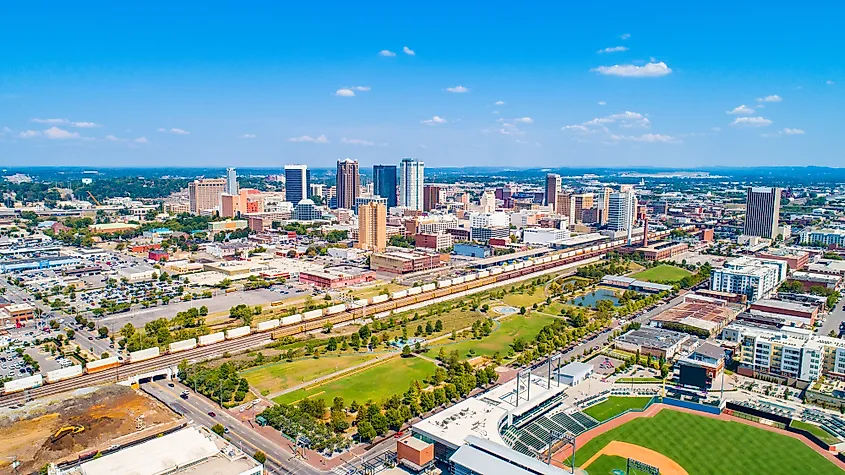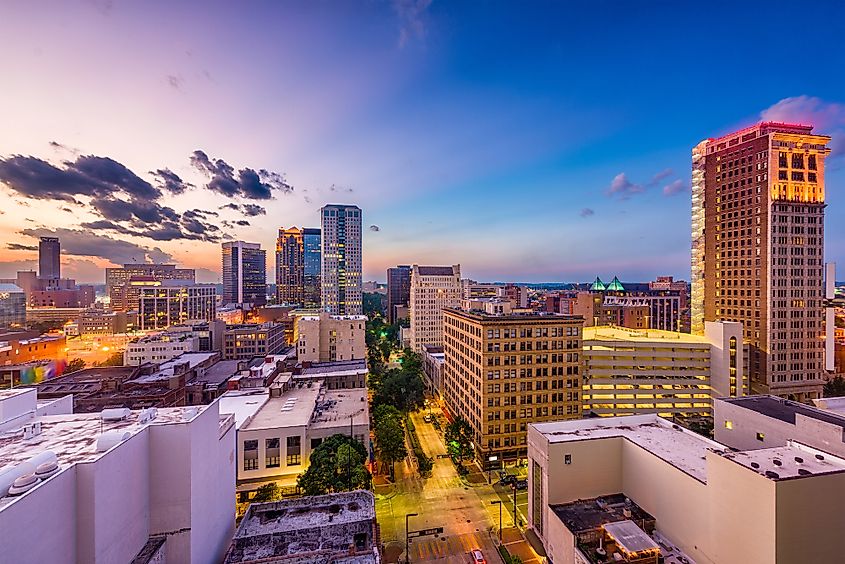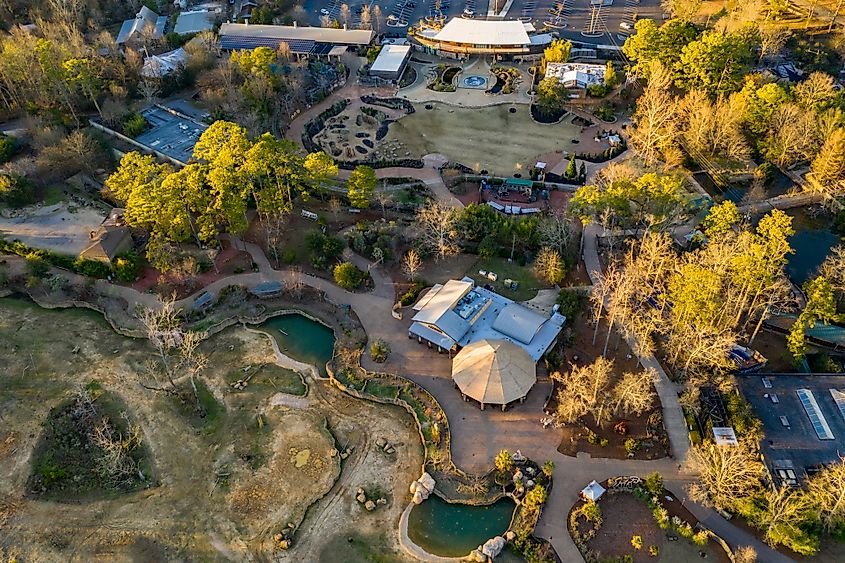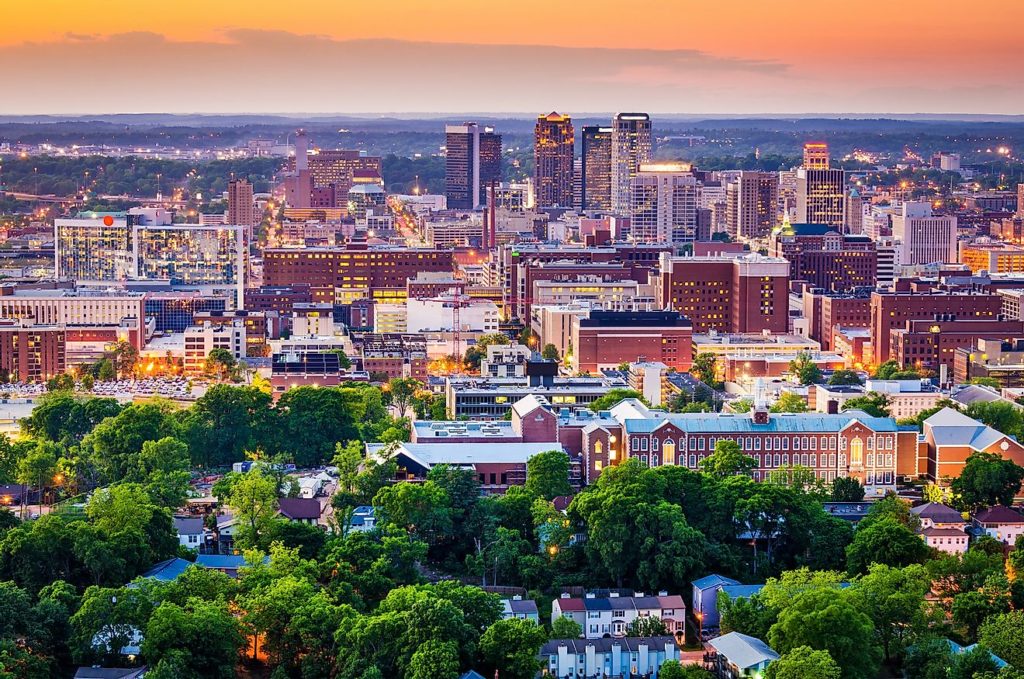The city of Birmingham was established 151 years ago in the year of 1870. Emerging from a dim history of violence, epidemics, and racial tensions, Birmingham has indeed come a long way. It has rebranded its image to become the “Magic City,” which upholds civil rights and racial equality and celebrates arts, sports, and science. Birmingham has moved away from dependency on natural resources by creating a vibrant community committed to growth through advancing the business culture and nurturing the social justice discourse.
Geography And Climate Of Birmingham

Birmingham is located in the northern central area of the US state of Alabama, 300 miles away from the Gulf of Mexico. The north and northeast regions of the city are nestled at the foothills of the Appalachian Mountains. It is situated in the Jones Valley, between a scale of hills and the Red Mountain Range. Such geography gives Birmingham a hilly landform type that extends 15 miles along the valley and has a land area of 149.54 square miles. Birmingham is placed in both the Jefferson and Shelby Counties. However, it is the administrative capital of Jefferson County which is the most populated in the state of Alabama.
The US Route 280, established in 1954, runs through Birmingham, connecting it to another city in the state of Alabama, Auburn. The US Route 280, 392 mi long, branches from the US highway 80 and cuts through various Southern Georgia and East Central Alabama areas. The highway becomes a major suburban route when it cuts through the city of Birmingham.
Birmingham is 90.6 miles away from the capital of the state of Alabama, Montgomery. The nearest city to Birmingham is Mountain Brook, only 5.5 miles (8.8 km). Birmingham is 58.6 mi, far from the principal town of Tuscaloosa in Alabama. It is near the city of Atlanta in the state of Georgia, with a distance of 146.5 miles (235.7 km). The city’s elevation is 620 Feet above sea level.
The city enjoys a moderate winter and warm summer season. The lowest temperature is 50.9 degrees, and the highest is 73.4 degrees. The climate of Birmingham, Alabama, could be described as humid-subtropical.
Winters in Birmingham are described as cold, rainy, and short. January is the coldest month. The temperature ranges between 36°F and 54°F. The cold season in Birmingham is 2.9 months, extending from November 29 until February 24.
Summers in Birmingham are described as long, hot, and humid. The warm season lasts 3.9 months extending from May 25 to September 2. The highest temperatures are recorded in July, during which the temperature ranges between 91°F and 72°F. The average daily temperature scores more than 83°F.
The city of Birmingham receives 1,440 millimeters (56.6 inches) of precipitation. Thus, the city is known for its significant and abundant rainfall. The driest month is October, during which precipitation averages 85 millimeters. March is the wettest month, during which precipitation averages 145 millimeters. The city receives 213 sunny days a year, only an average of 1.6 inches of snow per year and 56.12 inches of rain. Hurricanes are likely to impact the city, but not at full strength due to the city’s farness from the coast.
Jones Valley, where Birmingham is located, has several creeks, such as Village Creek, Valley Creek, and Five Mile Creek, tributaries Black Warrior River. Another set of creeks, such as the Shades Creek and the Little Cahaba River, are tributaries to the Cahaba River. Two large watersheds are the Cahaba River Watershed and the Black Warrior watershed. These two are the primary water sources for the residents of Birmingham.
Demographics Of Birmingham
As of 2022, Birmingham had a population of 206,151 people. The total number of adults in Birmingham is 169,592, of which 52.82% are females, and 47.18% are males. The median age among Birmingham’s population is 35.9 across both sexes. The old-age dependency ratio in Birmingham is 22.9, and the child dependency ratio is 31. According to the 2019 US Census, Birmingham has a predominantly black or African American race population constituting 69.85% of the population. White people form 25.81% of the population. The Hispanic race comprises 1.45% of the people, and American Indians 0.30%. Other non-Hispanic races constitute 1.49% of the people, and Asians constitute 1.1%. As of 2019, the overall marriage rate in the city is 28.7%.
History Of Birmingham

The city’s first people were the Cherokee, Choctaw, and Chickasaw tribes, who inhabited the Jones valley and fed off hunting. In 1815, John Jones and his group were the first white men to set foot in the area. They started by creating the village of Jonesboro, and in 1819 the county of Jefferson was established. The area’s population grew over the next few decades as iron ore became the primary natural resource and commodity. The iron ore trade developed throughout the American civil war but was destroyed in 1865. Since then, the valley’s progress was interrupted until 1871. In 1871, limestone and coal, alongside iron ore, were found essential for the steelmaking industry.
This potential was capitalized on by the Elyton Land Company, which built the city and named it “Birmingham” after the town in England, which produces steel.
After World War I, the city prospered because of new construction development. The newly built city endured fluctuations in population numbers. As it grew, it started confronting problems such as crime and disease. In the following decades, new issues emerged, such as labor troubles and local government corruption. During the Great Depression, Birmingham was devastated due to its extreme dependency on one industry, the steel industry. Birmingham started its recovery process when world war two was declared in Europe. At that time, steel demand grew in preparation for war. After world war two, the economy continued to develop and diversify. Despite that, the economy of Birmingham was not immune to the economic recession of 1957. Another battleground was the racial tensions between blacks and whites in the city. This tension resulted in episodes of violence, which convinced the city of the need for change.
Since the 1970s, Birmingham went through a paradigm shift that transformed the city into an atmosphere of racial harmony, a champion of civil rights, and a leader in healthcare, finance, and education. The town underwent a technological boom, which resulted in more employment, prosperity, and successful integration.
Economy Of Birmingham
The modern Birmingham economy is diversified. The most significant sectors are the medical industry, trade, finance, research, government, and a growing telecommunications sector. The city is the headquarters of many power companies such as SONAT and ENERGON Corporation. However, the medical and healthcare industry remains the overarching sector in the city and its biggest employer. Thus, the most popular and common job in Birmingham is registered nurse, which constitutes 3.71% of total employment in the town. The second-ranking most typical job is a salesperson in the retail industry. In 2020, Birmingham scored 62,830.706 $ in GDP. The median household income in Birmingham is $38,832 per year (2020), and the median individual income is $23,508 per year (2020). Lawyers, financial managers, software developers, and pharmacists are among the highest-paying jobs in Birmingham.
Attractions In Birmingham

The city of Birmingham, just like other cities in the south, is well known for its beautiful tourist attractions. The most popular of its historical and architectural sights are the Birmingham Civil Rights Institute and the Vulcan Park and Museum. Moreover, Birmingham has a spot for sports enthusiasts who can visit the Bartow Area; and learning enthusiasts who can see the McWane Science Center. Additionally, the city is hosting the 2022 World Games taking place from July 7 till July 17. Birmingham is a leader in green spaces, with more green spaces per capita than other cities in the US of similar size.
Birmingham is known for its vibrant craft beer scene and diverse international culinary setting.
